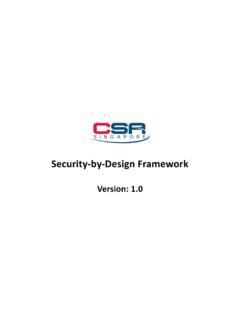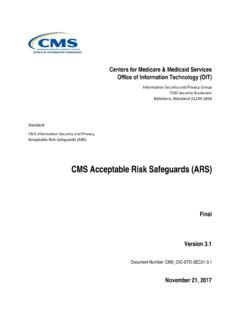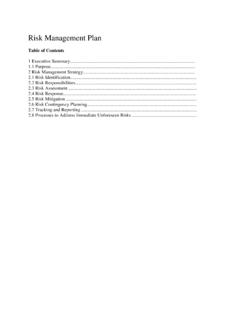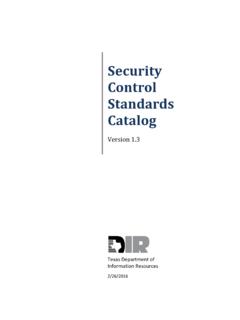Transcription of GUIDE TO CONDUCTING CYBERSECURITY RISK …
1 GUIDE TO CONDUCTING CYBERSECURITY RISK assessment FOR critical information INFRASTRUCTURE DECEMBER 2019 GUIDE to CONDUCTING CYBERSECURITY Risk assessment for critical information Infrastructure Dec 2019 1 CONTENTS 1 INTRODUCTION .. 2 Importance of CYBERSECURITY Risk assessment .. 2 Common Problems Observed .. 2 2 PURPOSE, AUDIENCE & SCOPE .. 4 Purpose of Document .. 4 Audience & Scope .. 4 3 ESTABLISH RISK CONTEXT .. 5 Define Risk .. 5 Determine Risk Tolerance .. 6 Define Roles and Responsibilities .. 7 4 CONDUCT RISK assessment .. 8 Step 1: Risk Identification .. 8 Step 2: Risk Analysis .. 11 Step 3: Risk Evaluation .. 16 5 RESPOND TO risks .. 18 Types of Risk Response Options .. 18 Choosing the Appropriate Risk Response Actions .. 19 6 REFERENCES .. 20 ANNEX .. 21 Summary of Expectations for CIIOs .. 21 GUIDE to CONDUCTING CYBERSECURITY Risk assessment for critical information Infrastructure Dec 2019 2 1 INTRODUCTION Importance of CYBERSECURITY Risk assessment With rapid advancement in technology, shifting cyber threat landscape and increased digitalisation, organisations may be exposing themselves to greater CYBERSECURITY risks that may potentially have an adverse impact to their organisation and business objectives.
2 Thus, it is imperative for organisations to manage these CYBERSECURITY risks effectively. CYBERSECURITY risk assessment (referred to as risk assessment ) is an integral part of an organisation s enterprise risk management process. By CONDUCTING a risk assessment , organisations would be able to: Identify what could go wrong events that are often a result of malicious acts by threat actors and could lead to undesired business consequences. Determine the levels of CYBERSECURITY risk that they are exposed to. A good understanding of the risk levels would allow an organisation to dedicate adequate action and resources to treat risks of the highest priority. Create a risk-aware culture within the organisation. Risk assessment is an iterative process that involves engaging employees to think about technology risks and how they align to business objectives.
3 Common Problems Observed While organisations recognise that risk assessment is an important part of their enterprise risk assessment practice, many struggled with the process to conduct a proper risk assessment . Some of the common gaps observed include the following: Poor articulation of risk scenarios Risk scenarios describing what could go wrong events were often vague and generic without articulating specific threat events, vulnerabilities, assets and consequences. As a result, it is difficult to understand the extent of the risks , relate them to the organisational context, or identify targeted measures to address the risks . Identification of risks using a compliance-oriented approach Many organisations identify risks from the point of assessing security controls (or lack thereof), similar to performing a compliance audit or gap analysis against a set of defined standards.
4 A compliance-oriented approach towards risk assessment drives a checklist behaviour, giving a false sense of security that an organisation is not exposed to any risks as long as they fulfil all compliance requirements. GUIDE to CONDUCTING CYBERSECURITY Risk assessment for critical information Infrastructure Dec 2019 3 Absence of risk tolerance Organisations often do not integrate their CYBERSECURITY risk management plans into their enterprise risk management programme. As a result, CYBERSECURITY risk tolerance at the enterprise level is often ignored, and management face difficulty in deciding the appropriate level of risk-taking to adopt whilst in pursuit of their organisation s business objectives. Determining risk likelihood based on historical or expected occurrences Organisations have traditionally used the measure of time/frequency ( historical or expected occurrences of events) to estimate their risk likelihood.
5 The approach may be inaccurate when it is based on the number of times an incident has occurred previously, especially when there is lack of information on past CYBERSECURITY incidents. In the context of CYBERSECURITY , the likelihood of a CYBERSECURITY incident is independent of the frequency of past occurrence. Treating risks with irrelevant controls/measures Organisations may take a broad approach in coming up with measures to mitigate identified CYBERSECURITY risks , resulting in the implementation of controls that do not fully address the root cause. This often stems from a poor understanding or articulation of risk scenarios. GUIDE to CONDUCTING CYBERSECURITY Risk assessment for critical information Infrastructure Dec 2019 4 2 PURPOSE, AUDIENCE & SCOPE Purpose of Document The purpose of this document is to provide guidance to critical information Infrastructure Owners (CIIOs) on how to perform a proper CYBERSECURITY risk assessment .
6 This document will also identify expectations that are required of CIIOs to take note when performing their risk assessment . The expectations are denoted with the icon below in this guidance document. Audience & Scope This document is meant for use by both internal and external stakeholders but not limited to, the following: Stakeholders ( business unit heads, system owners, Chief information Security Officers, etc.) within any organisations, including CIIOs External consultants or service providers CONDUCTING risk assessment on behalf of organisations. The scope of this guidance focuses only on the areas of risk framing, assessment and treatment. Other areas such as risk monitoring and reporting, which comes under a wider domain of risk management, is beyond the scope of this guidance. GUIDE to CONDUCTING CYBERSECURITY Risk assessment for critical information Infrastructure Dec 2019 5 3 ESTABLISH RISK CONTEXT Establishing risk context is an important pre-requisite for CONDUCTING risk assessment .
7 This step ensures that internal and external stakeholders involved in the risk assessment exercise have a common understanding of how the risk is framed, the risk tolerance to consider and the responsibilities of the risk owner. Define Risk There are many definitions of CYBERSECURITY risk. Hence, before going further into the details of CONDUCTING a risk assessment , it is important to establish a common definition of CYBERSECURITY risk. For the purpose of this guidance document, risk is defined as the function1 of: The likelihood of a given threat event exercising on a vulnerability of an asset; and The resulting impact of the occurrence of the threat event Each of the risk factors mentioned in the definition is explained below. Threat Event Threat event refers to any event during which a threat actor2, by means of threat vector3, acts against an asset in a manner that has the potential to cause harm.
8 In the context of CYBERSECURITY , threat events can be characterised by the tactics, techniques and procedures (TTP) employed by threat actors. Vulnerability Vulnerability refers to a weakness in the design, implementation and operation of an asset, or the internal control of a process. Likelihood Likelihood refers to the probability that a given threat event is capable of exploiting a given vulnerability (or set of vulnerabilities). The probability can be derived based on factors namely, discoverability, exploitability and reproducibility. 1 The function of risk is adapted from National Institute of Standards and Technology Special Publication 800-30 Revision 1 (NIST SP 800-30R1) 2 Threat actor refers to a person or entity that is responsible for an event that has the potential to cause harm. 3 Threat vector refers to the path or route that a threat actor uses to attack a target.
9 Risk = Function (Likelihood, Impact) GUIDE to CONDUCTING CYBERSECURITY Risk assessment for critical information Infrastructure Dec 2019 6 Impact Impact refers to the magnitude of harm resulting from a threat event exploiting a vulnerability (or set of vulnerabilities). The magnitude of harm can be estimated from the perspective of a nation, organisation, or individual. Determine Risk Tolerance Risk tolerance4 is defined as the level of risk taking acceptable to achieve a specific business objective. Determining risk tolerance allows the Management to articulate how much risk the organisation is willing to accept. A well-defined risk tolerance should articulate: Expectations for treating and pursuing specific types of risk Boundaries and thresholds of acceptable risk taking Figure 1 below is an example of a risk tolerance table and must be tailored according to each organisation s context.
10 Risk Level Risk Tolerance Description Very High This level of risk cannot be accepted and would create an impact so severe that the related activity would need to cease immediately. Alternatively, mitigation or transference strategies need to be taken immediately. High This level of risk cannot be accepted. Treatment strategies aimed at reducing the risk level should be developed and implemented in the next 1 month. Medium High This level of risk cannot be accepted. Treatment strategies aimed at reducing the risk level should be developed and implemented in the next 3-6 months. Medium This level of risk can be accepted if there are no treatment strategies that can be easily and economically implemented. The risk must be regularly monitored to ensure that any change in circumstance is detected and acted upon appropriately. Low This level of risk can be accepted if there are no treatment strategies that can be easily and economically implemented.





